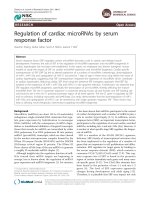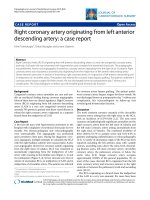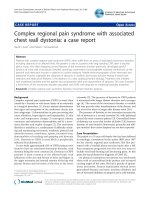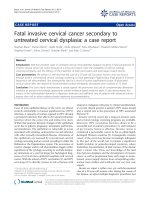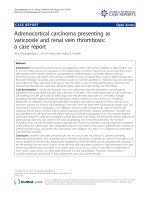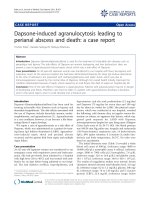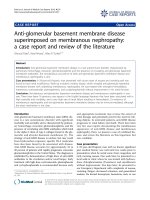Báo cáo y học: "Retention of foreign body in the gut can be a sign of congenital obstructive anomaly: a case report" potx
Bạn đang xem bản rút gọn của tài liệu. Xem và tải ngay bản đầy đủ của tài liệu tại đây (260.79 KB, 3 trang )
BioMed Central
Page 1 of 3
(page number not for citation purposes)
Journal of Medical Case Reports
Open Access
Case report
Retention of foreign body in the gut can be a sign of congenital
obstructive anomaly: a case report
Pravas Chandra Subudhi
1
, Shivaram Prasad Singh*
2
, Chudamani Meher
3
and Omprakash Agrawal
3
Address:
1
Department of Pediatric Surgery, SCB Medical College, Cuttack 753007, Orissa, India,
2
Department of Gastroenterology, SCB Medical
College, Cuttack 753007, Orissa, India and
3
Beam Diagnostics, Cuttack 753001, Orissa, India
Email: Pravas Chandra Subudhi - ; Shivaram Prasad Singh* - ;
Chudamani Meher - ; Omprakash Agrawal -
* Corresponding author
Abstract
Introduction: Small smooth objects that enter the gut nearly always pass uneventfully through the
gastrointestinal tract. Retention of foreign objects may occur due to congenital obstructive
anomaly of the gut.
Case presentation: We report here a child who presented with features of small gut obstruction
which were attributed to a foreign body impacted in the intestine. At surgery, an annular pancreas
was detected and the foreign body was found to be lodged in the distended proximal duodenum.
Conclusion: The reported case highlights the fact that an impacted radio-opaque foreign body in
a child should warn the pediatrician to the possibility of an obstructive congenital anomaly.
Introduction
Small round or oval objects that enter the stomach nearly
always pass uneventfully through the gastrointestinal tract
without requiring intervention. The retention of foreign
objects within the duodenum is suggestive of partial
obstruction, usually of congenital origin [1-3]. We
describe a child presenting with features of high intestinal
obstruction where retention of such an object led to the
discovery of congenital duodenal stenosis producing par-
tial obstruction.
Case presentation
A 32-month-old boy presented with a history of intermit-
tent vomiting over the previous 15 months. The vomitus
was generally non-bilious but occasionally bilious. The
parents also noticed intermittent distension of his abdo-
men which subsided after vomiting. The symptoms
seemed to commence after the child had swallowed a
metallic pendant which was coin-shaped and about 12
mm in diameter; at the time of swallowing, the child was
about 17 months old. He underwent repeated plain
upright radiographs of the abdomen to localize the for-
eign body and to determine whether it had been passed.
However, these continued to detect the foreign body. The
last plain radiograph (Figure 1) of his abdomen showed
the foreign body to be located in the right lower quadrant
and it was surmised that the intestinal obstruction was
due to impaction of the foreign body in the region of the
terminal ileum. The child's parents were therefore advised
that their child needed to undergo surgery for relief of the
obstruction. However, a review of the plain upright radio-
graph of the abdomen showed the presence of a 'double
Published: 9 September 2008
Journal of Medical Case Reports 2008, 2:293 doi:10.1186/1752-1947-2-293
Received: 16 December 2007
Accepted: 9 September 2008
This article is available from: />© 2008 Subudhi et al; licensee BioMed Central Ltd.
This is an Open Access article distributed under the terms of the Creative Commons Attribution License ( />),
which permits unrestricted use, distribution, and reproduction in any medium, provided the original work is properly cited.
Journal of Medical Case Reports 2008, 2:293 />Page 2 of 3
(page number not for citation purposes)
bubble sign', in addition to a few dilated loops of small
bowel in the left upper quadrant. A pre-operative diagno-
sis of duodenal obstruction was made with the possibility
of another obstructive lesion in the small bowel. The for-
eign body was presumed to be lodged somewhere in the
ileal loops. The child was then subjected to exploratory
laparotomy. During surgery, his stomach and proximal
duodenum were found to be grossly dilated with thicken-
ing of their walls, and an annular pancreas was detected
encircling the second part of the duodenum. In addition,
there was a membrane with a small aperture in the duode-
num. Surprisingly, the metallic pendant was found lodged
in the duodenum along with lot of debris including berry
seeds. The third part of the duodenum was mobilized and
duodenoduodenostomy was performed without dividing
the pancreas.
Discussion
Retention of elongated or pointed objects in the duode-
num is a frequent problem. Long, sharp objects may per-
forate the duodenum and have been known to migrate
widely in the abdomen. Early removal of such objects has
been advised [4,5]. In addition, objects longer than 5 cm
frequently fail to negotiate the C-curve and become
impacted [5-7] and hence should be removed using an
endoscope if possible. For blunt objects, some authors
have also recommended intervention if the foreign body
remains in the same location for more than a week [4,5].
Small round, oval, or cuboidal foreign objects nearly
always pass through the gastrointestinal tract promptly,
and stasis of such objects in the stomach or duodenum is
extremely uncommon [1]. The retention of such foreign
objects within the duodenum suggests partial obstruction,
usually of congenital origin. In otherwise normal chil-
dren, duodenal stenosis, prolapsing duodenal diaphragm,
and annular pancreas may cause retention of swallowed
foreign objects [1].
There are a few reports of radio-opaque foreign objects
retained at the site of congenital duodenal obstruction [1-
3]. Patients with duodenal stenosis alone or duodenal ste-
nosis with annular pancreas may present with a variety of
retained foreign materials in the stomach or proximal
duodenum. Nuts, vegetable and fruit pits, and coins have
been discovered at operation. Repeated abdominal roent-
genograms should show that the foreign object is retained
within the stomach or, more frequently, within the proxi-
mal duodenum. Upper gastrointestinal tract examination
should confirm the presence of a duodenal anomaly.
Duodenoduodenostomy or duodenojejunostomy should
be performed after removal of the foreign object(s).
However, in spite of the persistence of the radio-opaque
foreign body on plain X-rays of the abdomen, the possi-
bility of an obstructing anomaly in this child was never
considered. He continued to suffer for about 15 months
until he was seen by a pediatric surgeon. However, even at
the tertiary center, initially the surgeon and radiologists
were confused by the location of the radio-opaque
shadow in his right lower quadrant and a diagnosis of
small gut obstruction was made; this was attributed to the
foreign body being impacted in the intestine. However,
during a review of the radiograph, the double bubble sign
was appreciated and duodenal obstruction was suspected.
At surgery, an annular pancreas was detected and the for-
eign body was found to be lodged in the distended proxi-
mal duodenum.
In adults, there are rare case reports of impaction by for-
eign bodies leading to detection of bowel stricture due to
acquired diseases such as Crohn's disease [8,9]. However,
in children with impaction or retention of foreign bodies,
a congenital obstructing anomaly should always be kept
in mind [1-3]. The case reported here was not subjected to
proper investigations pre-operatively. In cases of radio-
opaque foreign bodies, it is quite easy to follow the pas-
Plain radiograph of the abdomen showing the metallic foreign body in the right lower quadrant, the presence of a 'double bubble sign', and a few dilated loops of small bowel in the left upper quadrantFigure 1
Plain radiograph of the abdomen showing the metallic foreign
body in the right lower quadrant, the presence of a 'double
bubble sign', and a few dilated loops of small bowel in the left
upper quadrant.
Publish with BioMed Central and every
scientist can read your work free of charge
"BioMed Central will be the most significant development for
disseminating the results of biomedical research in our lifetime."
Sir Paul Nurse, Cancer Research UK
Your research papers will be:
available free of charge to the entire biomedical community
peer reviewed and published immediately upon acceptance
cited in PubMed and archived on PubMed Central
yours — you keep the copyright
Submit your manuscript here:
/>BioMedcentral
Journal of Medical Case Reports 2008, 2:293 />Page 3 of 3
(page number not for citation purposes)
sage of the object periodically by plain abdominal radiog-
raphy; however, this has limitations in studying bowel
obstructions from foreign bodies which are not radio-
opaque. Plain abdominal radiography has a sensitivity of
86% in the diagnosis of high-grade bowel obstruction and
this will demonstrate air fluid levels with dilated small
bowel loops [10,11]; an intramural width of small intes-
tine of 3 cm or less is considered abnormal. An abdominal
CT scan is of great help in diagnosing and detecting the
etiology of intestinal obstruction in 73–95% of cases [10-
12]. A CT scan may also be able to demonstrate the for-
eign body [8]. Generally, laparotomy is performed for
diagnosis and management in cases of impacted foreign
bodies in the gut. However, with increasing expertise,
laparoscopy can be equally effective with all of the other
advantages of a minimal access approach. Hence, laparos-
copy is now increasingly being employed for removal of
ingested foreign bodies impacted in the gastrointestinal
tract [13,14].
Conclusion
The present case is reported to highlight the fact that reten-
tion or non-passage of a radio-opaque foreign body in a
child should alert the treating doctors to the possibility of
an obstructive congenital anomaly.
Consent
Written informed consent was obtained from the parents
of the child for publication of this case report and accom-
panying image. A copy of the written consent is available
for review by the Editor-in-Chief of this journal.
Competing interests
The authors declare that they have no competing interests.
Authors' contributions
SPS assessed and interpreted the patient's gastrointestinal
symptoms and the investigations. CM and OA carried out
the radiological examination while PCS performed the
surgery on the child. All were major contributors in writ-
ing the manuscript and all authors read and approved the
final manuscript.
References
1. Kassner EG, Rose JS, Kottmeier PK, Schneider M, Gallow GM:
Retention of small foreign objects in the stomach and duode-
num. A sign of partial obstruction caused by duodenal anom-
alies. Radiology 1975, 114:683-686.
2. Stanley P, Law BS, Young LW: Down's syndrome, duodenal ste-
nosis/annular pancreas, and a stack of coins. Am J Dis Child
1988, 142:459-460.
3. Spitz I: Management of ingested foreign bodies in childhood.
Br Med J 1971, 4(5785):469-472.
4. Seo JK: Endoscopic management of gastrointestinal foreign
bodies in children. Indian J Pediatr 1999, 66(Suppl 1):S75-S80.
5. Eisen GM, Baron TH, Domnitz JA, Faigel DO, Goldstein JL, Johanson
JF, Mallery JS, Raddawi HM, VargoII JJ, Waring JP, Fanelli RD, Har-
bough JW: Guidelines for the management of ingested foreign
bodies. Gastrointest Endosc 2002, 55:802-806.
6. Erbes J, Babbitt DP: Foreign bodies in the alimentary tract of
infants and children. Appl Ther 1965, 7:1103-1109.
7. Christie DL, Ament ME: Removal of foreign bodies from
esophagus and stomach with flexible fiberoptic panendo-
scope. Pediatrics 1976, 57:931-934.
8. Slim R, Chemaly M, Yaghi C, Honein K, Moucari R, Sayegh R: Silent
disease revealed by a fruit. Gut 2006, 55:181.
9. Amonkar SJ, Hughes T, Browell DA: Crohn's disease discovered
by an obstructing chick pea. Br J Hosp Med (Lond) 2007, 68:445.
10. Lerma MA, Mariscal JME, Cordon FD, Abril AG, Oron EM, Perez
MJM: Small bowel obstruction caused by Snail's shell: Radio-
graphic and CT findings. J Comput Assist Tomogr 2002, 26:529-531.
11. Maglinte DD, Reyes BL, Harmon BH, Kelvin FM, Turner WW Jr, Hage
JE, Ng AC, Chua GT, Gage SN: Reliability and role of plain film
radiograph and CT in the diagnosis of small bowel obstruc-
tion. AJR 1996, 167:1451-1455.
12. Maglinte DD, Balthazar EJ, Kelvin FM, Megibow AJ: The role of radi-
ology in the diagnosis of small bowel obstruction. AJR 1997,
168:1171-1180.
13. Chin EH, Hazzan D, Herron DM, Salky B: Laparoscopic retrieval
of intraabdominal foreign bodies. Surg Endosc 2007, 21:1457.
Epub 2007 May 19.
14. Palanivelu C, Rangarajan M, Rajapandian S, Vittal SK, Maheshkumaar
GS: Laparoscopic retrieval of 'stubborn' foreign bodies in the
foregut: a case report and literature survey. Surg Laparosc
Endosc Percutan Tech 2007, 17:528-531.
